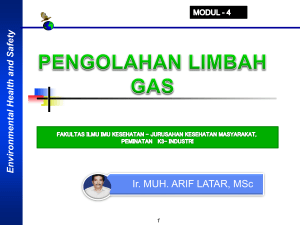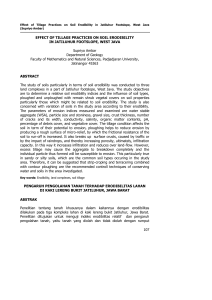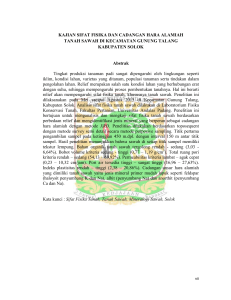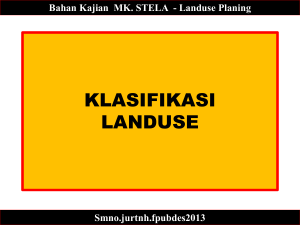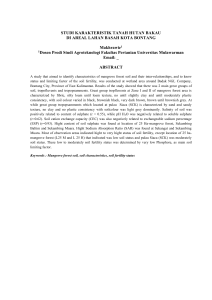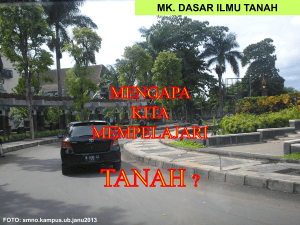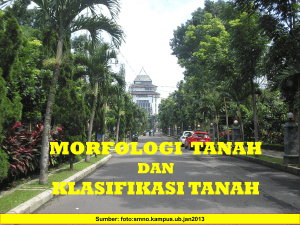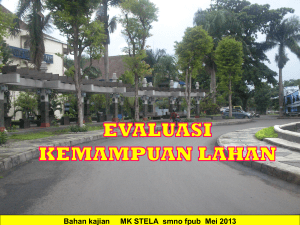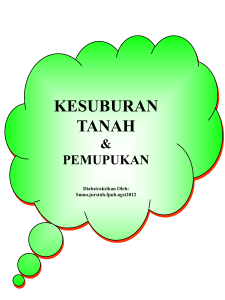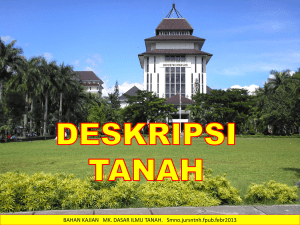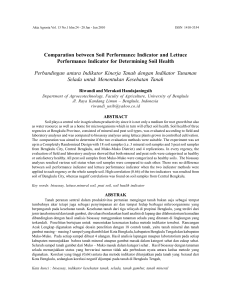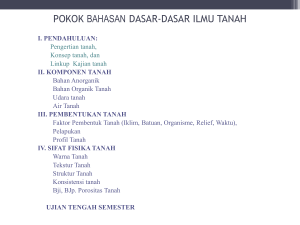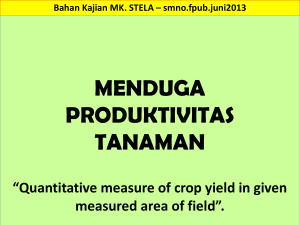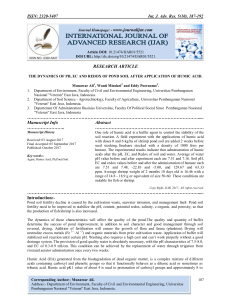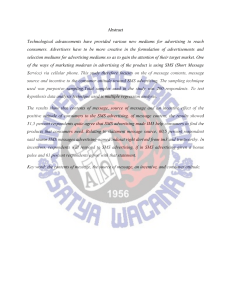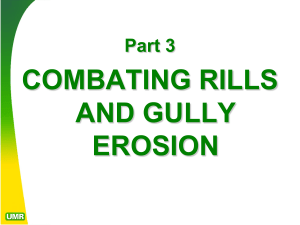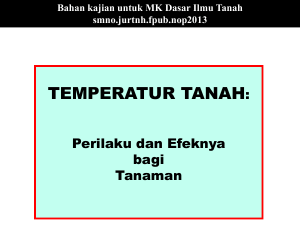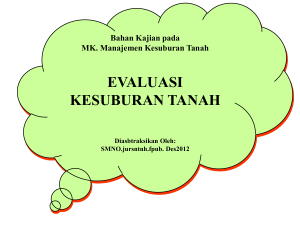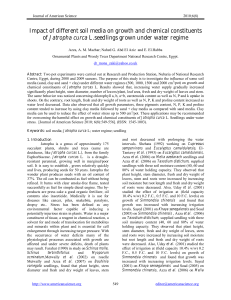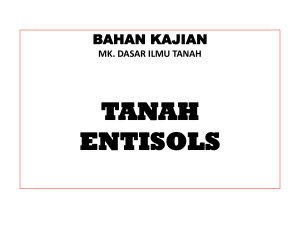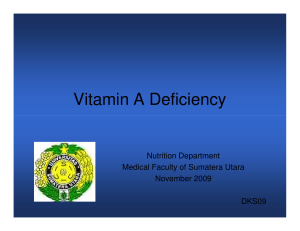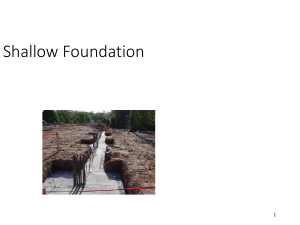dasar ilmu tanah koloid liat
advertisement
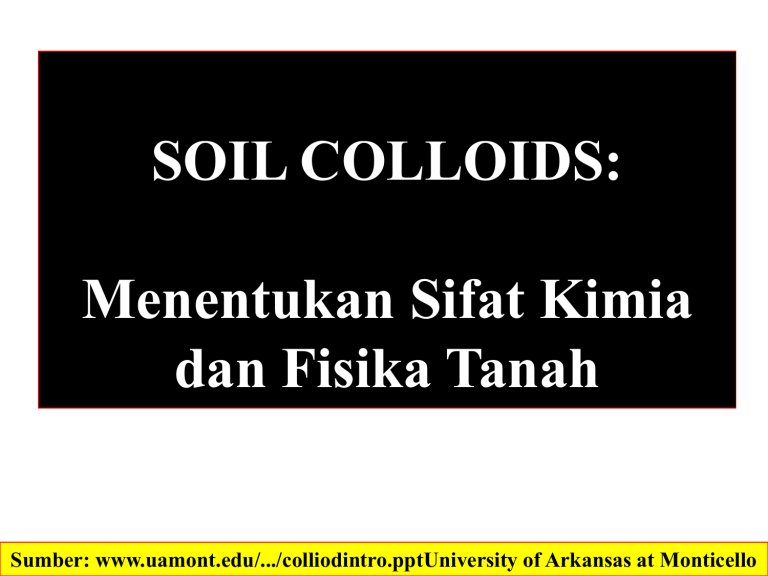
SOIL COLLOIDS: Menentukan Sifat Kimia dan Fisika Tanah Sumber: www.uamont.edu/.../colliodintro.pptUniversity of Arkansas at Monticello Apakah Koloid Tanah itu? Partikel mineral (liat) dan bahan organik (humus) yangterdispersi dalam matiks tanah, ukurannya sangat kecil (sangat halus) Sumber: www.uamont.edu/.../colliodintro.pptUniversity of Arkansas at Monticello Sifat-sifat Koloid. 1. 2. 3. 4. Luas-permukaan yang reaktif. Nature’s great electrostatic chemical reactor! Influence most all soil ecosystem functions. Site of cation absorption (loosely held) that are ‘exchangeable’. 5. Mampu mengikat “benda” lain, seperti pestisida dan virus. Sumber: www.uamont.edu/.../colliodintro.pptUniversity of Arkansas at Monticello Sumber: www.uamont.edu/.../colliodintro.pptUniversity of Arkansas at Monticello Sumber: www.uamont.edu/.../colliodintro.pptUniversity of Arkansas at Monticello Sumber: www.uamont.edu/.../colliodintro.pptUniversity of Arkansas at Monticello Sumber: www.uamont.edu/.../colliodintro.pptUniversity of Arkansas at Monticello IKATAN OKTAHEDRA-TETRAHEDRA Sumber: www.uamont.edu/.../colliodintro.pptUniversity of Arkansas at Monticello SUBSTITUSI ISOMORFIK Sumber: www.uamont.edu/.../colliodintro.pptUniversity of Arkansas at Monticello MODEL LIAT TIPE 2:1. MONTMORILONIT (SMEKTIT) Sumber: www.uamont.edu/.../colliodintro.pptUniversity of Arkansas at Monticello Sumber: www.uamont.edu/.../colliodintro.pptUniversity of Arkansas at Monticello REAKSI PERTUKARAN KATION Sumber: www.uamont.edu/.../colliodintro.pptUniversity of Arkansas at Monticello Cation Exchange Capacity (CEC) KAPASITAS TUKAR KATION (KTK) CEC = the sum of exchangeable cations that a soil can absorb. CEC is expressed as the number of moles of positive charge adsorbed per unit mass. Units: Cmol (+) kg-1 or Meq per 100 g soil Sumber: www.uamont.edu/.../colliodintro.pptUniversity of Arkansas at Monticello Muatan listrik pada beberapa Koloid Tanah Koloid Tanah Muatan yang tergantung pH (%) Tipe Rataan KTK Bahan Organik amorphous 200 90 Smectite Vermicullite Fine micas Chlorite Kaolinite Gibbsite (Al) Geothite (Fe) Allophane 2:1 100 5 2:1 150 5 2:1 30 20 2:1:1 30 20 1:1 8 95 Non-silicate 4 100 Non-silicate 4 100 Si Non-cystalline 30 90 Sumber: www.uamont.edu/.../colliodintro.pptUniversity of Arkansas at Monticello Koloid Tanah Permukaan koloid tanah bermuatan negatif atau positif, yang dapat menarik atau menolak ion-ion yang muatannya berlawanan bersama dnegan molekul air. Ion-ion yang tertarik (terjerap) pd permukaan koloid ini (Ion-tukar) dapat diserap oleh akar tanaman. Sumber: http://faculty.yc.edu/ycfaculty/ags105/week08/soil_colloids/soil_colloids_print.html Koloid Tanah Partikel liat Silicate adalah kristalin, tersusun atas dua lembaran. Salah satu lembaran ini adalah bidang atom Si yang dikelilingi oleh atok oksigen. Atom Oksigen ini bergfungsi sebgaai jembatan penghubung untuk bergabung dnegan lembaran aluminium dan/atau magnesium yang dikelilingi oleh atom oksigen dan gugusan hidroksil. Sumber: http://faculty.yc.edu/ycfaculty/ags105/week08/soil_colloids/soil_colloids_print.html Koloid Liat Tanah Berdasarkan jumlah dan susunan lembaran tetrahedral (silica) dan octahedral (aluminamagnesia) yg terkandung dalam unit kristal; liat silikat dikelompokkan menjadi dua: (a) mineral liat tipe 1:1 (satu lembar tetrahedral dan satu lembar octahedral) dan (b) liat tipe 2:1. Kristal Tipe 1:1 (mis. kaolinite) ukurannya lebih besar dibanding tipe lainnya dan strukturnya kaku (fixed) tidak mempunyai permukaan-internal dan sedikit sekali substitusi isomorfiknya. Oleh karena itu, mineral ini mempunyai luas-permukaan yang relatif rendah dan kapasitasnya untuk menarik kation juga rendah. Mineral ini tidak mengembang kalau basah dan tidak mengkerut kalau kering. Sumber: http://faculty.yc.edu/ycfaculty/ags105/week08/soil_colloids/soil_colloids_print.html Koloid Liat Tanah Model of two crystal layers and an interlayer characteristic of montmorillonite, a smectite expanding-lattice 2:1-type clay mineral. Each layer is made up of an octahedral sheet sandwiched between two tetrahedral sheets with shared apical oxygen atoms. There is little attraction between oxygen atoms in the bottom tetrahedral sheet of one unit and those in the top tetrahedral sheet of another. This permits a variable space between layers, which is occupied by water and exchangeable cations. The internal surface area thus exposed far exceeds the surface around the outside of the crystal. Note that magnesium has replaced aluminum in some sites of the octahedral sheet. Likewise, some silicon atoms in the tetrahedral sheet may be replaced by aluminum (not shown). These substitutions give rise to a negative charge, which accounts for the high cation exchange capacity of this clay mineral. A ball-andstick model of the atoms and chemical bonds is at the right. Sumber: http://faculty.yc.edu/ycfaculty/ags105/week08/soil_colloids/soil_colloids_print.html Koloid Liat Tanah Two clay groups with 2:1 type structures have expansive type crystals, the smectites and vermiculites. Sumber: http://faculty.yc.edu/ycfaculty/ags105/week08/soil_colloids/soil_colloids_print.html Koloid Liat Tanah Model of a 2:1-type nonexpanding lattice mineral of the fine-grained mica group. The general constitution of the layers is similar to that in the smectites, one octahedral sheet between two tetrahedral sheets. However, potassium ions are tightly held between layers, giving the mineral a more or less rigid type of structure that prevents the movement of water and cations into the space between layers. The internal surface and cation exchange capacity of fine-grained micas are thus far below those of the smectites. Sumber: http://faculty.yc.edu/ycfaculty/ags105/week08/soil_colloids/soil_colloids_print.html Koloid Tanah: Gibbsite A simplified diagram showing the structure of gibbsite, an aluminum oxide clay common in highly weathered soils. This clay consists of dioctahedral sheets (two are shown) that are hydrogen-bonded together. Other oxide-type clays have iron instead of aluminum in the octahedral positions, and their structures are somewhat less regular and crystalline than that shown for gibbsite. The surface plane of covalently bonded hydroxyls gives this, and similar clays, the capacity to strongly adsorb certain anions. Sumber: http://faculty.yc.edu/ycfaculty/ags105/week08/soil_colloids/soil_colloids_print.html Koloid Tanah - Humus A simplified diagram showing the principal chemical groups responsible for the high amount of negative charge on humus colloids. The three groups highlighted all include –OH that can lose its hydrogen ion by dissociation and thus become negatively charged. Note that the carboxylic, phenolic, and alcoholic groups on the right side of the diagram are shown in their disassociated state, while those on the left side still have their associated hydrogen ions. Note also that association with a second hydrogen ion causes a site to exhibit a net positive charge. Sumber: http://faculty.yc.edu/ycfaculty/ags105/week08/soil_colloids/soil_colloids_print.html Koloid Tanah A diagrammatic representation of the adsorption of ions on a colloid by the formation of outer-sphere and inner-sphere complexes. (1) Water molecules surround diffuse cations and anions (such as the Mg2+, Cl-, and HPO4shown) in the soil solution. (2) In an outer-sphere complex (such as the adsorbed Ca2+ ion shown), water molecules form a bridge between the adsorbed cation and the charged colloid surface. (3) In the case of an inner-sphere complex (such as the adsorbed H2PO4— anion shown), no water molecules intervene, and the cation or anion binds directly with the metal atom (aluminum in this case) in the colloid structure. Sumber: http://faculty.yc.edu/ycfaculty/ags105/week08/soil_colloids/soil_colloids_print.html Koloid Tanah Penjerapan Kation dan Anion Colloids attract and hold a complex swarm of cations and anions. Hydrated ions from the soil solution are surrounded by a shell of water molecules. These hydrated ions are attracted to sites on the colloid surface that bear a charge of the opposite sign to the charge of the hydrated ion. As they approach the surface of the colloid, they are loosely held by mutual attraction of the charge colloid site and the ion for opposite ends of the intervening water molecules. This type of sorption is termed outer sphere complexation, and is readily reversible. Exchangeable ions are examples. Other ions may bond directly with the atoms of the clay surface, forming much stronger, more difficult to reverse relationships known as inner sphere complexes. Phosphate ions strongly sorbed or fixed to the hydroxyl plane of the octahedral sheet and metal ions strongly sorbed to the oxygen plane of tetrahedral sheets are examples. Sumber: http://faculty.yc.edu/ycfaculty/ags105/week08/soil_colloids/soil_colloids_print.html Koloid Tanah The ions attracted to and adsorbed on the surface of the soil colloids are subject to exchange with ions in the soil solution or on plant roots. Such exchangeable ions serve as valuable storage assets for plants, the ions being held from loss by leaching or runoff but remaining available for later uptake by plants. H+ ions created by root respiration will exchange for K+, Mg2+ and Ca2+ for example, that can then be taken up by plants. Sumber: http://faculty.yc.edu/ycfaculty/ags105/week08/soil_colloids/soil_colloids_print.html Koloid Tanah KTK (CEC = Cation Exchange Capacity) The cation exchange capacity (CEC) of a soil is determined primarily by the amount and nature of the soil colloids and by the pH. Soils high in smectite and vermiculite clays have high CEC values at all pH levels, those high in fine-grained micas and chlorites being intermediate. The CEC of kaolinite and the Fe, Al oxides is quite low. In very acid soils the CEC of humus is also quite low, but under neutral to alkaline conditions humus may have a CEC that, on a weight basis, several fold exceeds that of smectite. Sumber: http://faculty.yc.edu/ycfaculty/ags105/week08/soil_colloids/soil_colloids_print.html Koloid Tanah- Pertukaran ion Kemampuan tanah mendukung produktivitas tanaman - ditentukan oleh karakteristik koloid tanah dasn KTK tanah Sumber: http://clasfaculty.ucdenver.edu/callen/1202/Soils/Soils.html Koloid Tanah Exchange of cautions between a root and soil colloids. Bahan organik mempunyai permukaan yang sangat luas, sehingga banyak mempunyai tapak-tapak pertukaran ion. Semakin banyak kandungan BOT suatu tanah, semakin banyak hara tersedia bagi tanaman. Sumber: Hi-Fert, Plant Nutrition and Soil Fertility, 1997
